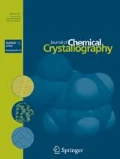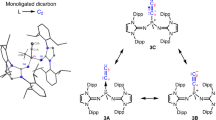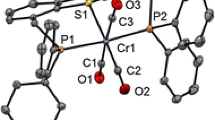Abstract
The structures of the (benzene dialkylacetal)tricarbonyl chromium complexes [η6-C6H5-CH(OR)2]Cr(CO)6 (R=Me,1; Et,2), are reported. The compounds were examined as part of a study of the conformations of the tripodal tricarbonylchromium group. For [η6-C6H5-CH(OMe)2]Cr(CO)3,1, monoclinic,P21/c (# 14),a=15.235(1) Å,b=6.5304(5) Å,c=12.702 Å, β=103.197(1)o,Z=4. For [η6-C6H5-CH(OEt)2]Cr(CO)3,2, monoclinic,P21/c (# 14),a=9.859(3) Å,b=10.547(3) Å,c=15.138(3) Å, β=108.42(2)o,Z=4. The data show that the molecules adopt the expected “three-legged piano stool” structure. The carbonyl ligands in1 adopt an eclipsed arrangement with respect to the arene ring and its substituent, while those in2 are staggered. These conformations are consistent with the notion that the acetal substituent behaves largely as an electroneutral group, or at most as a weak electronic acceptor.
Similar content being viewed by others
References
Solladie-Cavallo, A.Polyhedron 1985,4, 901.
Muetterties, E.L.; Bleeke, J.R.; Wucherer, E.J.; Albright, T.A.Chem. Rev. 1982,82, 499.
Albright, T.A.Trans. Am. Cryst. Assn. 1980,16, 35.
Albright, T.A.; Hofmann, P.; Hoffmann, R.J. Am. Chem. Soc. 1977,99, 7546.
Gilbert, T.M.; Bond, A.H.; Rogers, R.D.J. Organomet. Chem. 1994,479, 73.
Hunter, A.D.; Mozol, V.; Tsai, S.D.Organometallics 1992,11, 2251.
Hunter, A.D.; Shilliday, L.; Furey, W.S.; Zaworotko, M.J.Organometallics 1992,11, 1550.
Gilbert, T.M.; Hadley, F.D.; Bauer, C.B.; Rogers, R.D.Organometallics 1994,13, 2024.
Drefahl, G.; Horhold, H.-H.; Kuhne, K.Chem. Ber. 1965,98, 1826.
Allen, F.H.; Kennard, O.; Taylor, R.Acc. Chem. Res. 1983,16, 146.
Sheldrick, G.M.Acta Cryst. 1990,A46, 467.
Sheldrick, G.M. SHELX76, a system of computer programs for X-ray structure determination, as locally modified; University of Cambridge, England, 1976.
Sheldrick, G. SHELXTL, a suite of computer programs for X-ray structure determination, sold by Siemens Analytical Instruments, Inc., Madison, WI, USA.
Davis, R.; Kane-Maguire, L.A.P. InComprehensive Organometallic Chemistry; G. Wilkinson, F.G.A. Stone and E.W. Abel, Ed.; Pergamon: Oxford, 1982; Vol. 3 pp. 953–1077.
The τ angle for1 is the torsion angle C9-Centroid-Cr-C2, while for2 it is C9-Centroid-Cr−Cl.
Author information
Authors and Affiliations
Rights and permissions
About this article
Cite this article
Gilbert, T.M., Bauer, C.B. & Rogers, R.D. Structures of 355-1355-1355-1tricarbonyl: structural evidence for the near-electroneutrality of the dialkylacetal substituent. J Chem Crystallogr 26, 355–360 (1996). https://doi.org/10.1007/BF01677100
Received:
Issue Date:
DOI: https://doi.org/10.1007/BF01677100




